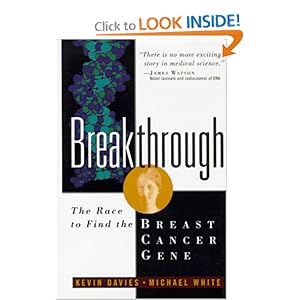
Personalized Medicine and BRCA Case Study
Media buzz about ‘personalized medicine’ increased quite a bit over the last 1-2 years. It is being proposed that we are on the verge of a major medical breakthrough in cancer treatment because of falling costs in DNA sequencing. To separate wheat from chaff in those claims, let us revisit four most exciting years of cancer research in recent history.
Geneticists in lab coat rarely get featured in NY Times, but the period 1990-1994 were different. Media covered ‘international race to find breast cancer gene’ with as much attention as they do for major sports events. When the coveted gene was finally found, NY Times wrote -
Capturing a genetic trophy so ferociously coveted and loudly heralded that it had taken on a near-mythic aura, a collaborative team of researchers has announced the discovery of a gene whose mutation causes hereditary breast cancer.
Although the researchers caution that they are still far from developing a diagnostic test as a result of their finding, the announcement will be of great relevance to many of the women who now suspect they carry a familial risk of breast cancer.
This Nature Genetics article provides more details on the nature of the race, and disappointments among those who could not get the gene faster than Myrian Genetics. Two years later, Kevin Davies wrote his book Breakthrough: The Race to Find the Breast Cancer Gene for ordinary people, and described the race as “proof that modern medicine can at last offer something tangible in the battle against a unique disease about which shockingly little is known.”

The race began in October 1990, when Dr. Mary-Claire King startled the American Society of Human Genetics with the news that after fifteen years, her research group had found irrefutable evidence of a gene linking heredity and the risk of breast cancer. From that moment on, the quest to isolate the gene became the focus of worldwide attention, eventually reaching fever pitch. In a race against time and one another, “researchers relentlessly zeroed in on a piece of DNA too small to see, for a prize too enormous to contemplate.”
In addition to the pioneering Dr. King, the distinguished scientists profiled include the renowned Francis Collins, who discovered the genes for cystic fibrosis and Huntington’s disease, and Mark Skolnick, the entrepreneurial founder of Myriad Genetics, who made fascinating use of the genealogical records of Mormons in his quest for the gene. The intensity of the project brought out the extremes of scientific research, from exhilarating enthusiasm and cooperation to heated rivalry.
Beyond its fast-paced chronicle of discovery, Breakthrough is also a story of the politics of illness, focusing on the impact of the women’s movement on breast cancer research and the changing attitudes of the past twenty-five years. Although, as the authors state, our “heightened awareness of the disease has been very late in coming,” there is genuine cause for hope. Looking to the future, they explore current methods of screening and treatment as well as the prospects for a cure.
In the United States alone, 183,000 new cases of breast cancer are diagnosed each year50,000 in women under the age of forty. Breakthrough is proof that modern medicine can at last offer something tangible in the battle against a unique disease about which shockingly little is known.
Now that we are 20 years away from the end of race, it is possible to revisit the promises and their outcome. We believe many claims and discoveries on ‘personalized genetics’ will go through similar process.
What happened since the? Here are few observations.
1. Patent Struggle: One promise of BRCA1 discovery was to facilitate early testing of breast cancer. Myriad Genetics found a second gene BRCA2 shortly afterward, and patented the gene.
Myriad is the exclusive licensee of these patents and has enforced them in the US against clinical diagnostic labs.[12] This business model led from Myriad being a startup in 1994 to being a publicly traded company with 1200 employees and about $500M in annual revenue in 2012;[11] it also led to controversy over high prices and the inability to get second opinions from other diagnostic labs, which in turn led to the landmark Association for Molecular Pathology v. Myriad Genetics lawsuit.[12][67] The patents begin to expire in 2014.
According to an article published in the journal, Genetic Medicine, in 2010, “The patent story outside the United States is more complicated. For example, patents have been obtained but the patents are being ignored by provincial health systems in Canada. In Australia and the UK, Myriads licensee permitted use by health systems, but announced a change of plans in August 2008. … Only a single mutation has been patented in Myriads lone European-wide patent, although some patents remain under review of an opposition proceeding. In effect, the United States is the only jurisdiction where Myriads strong patent position has conferred sole-provide status.” Peter Meldrum, CEO of Myriad Genetics, has acknowledged that Myriad has “other competitive advantages that may make such [patent] enforcement unnecessary” in Europe.
So, Americans lost money for sponsoring the discovery and winning the race. Even though Myriad found the first and second gene after winning four year ‘race’, the lead was generated through Dr. King’s lab in Berkeley after her 15 years of research.
2. Too Many Cancer Genes: Even if one can get genetic testing for cancer, it does not say much about chances of having cancer except for few familial cases. There are simply too many genes and too many mutations now linked to cancer.
3. Locked up paper: The original paper of Dr. King, which determined the general location of the hereditary breast cancer gene in chr 17 is still locked up. So, not only people lost in their ability to get diagonosed after paying for the research, they also lost their right to even see the breakthrough papers.
4. Forgotten Discovery: Dr. King’s discovery that started the intense four year international race isn’t even listed among National Cancer Institute’s 150 years of advances against cancer.
5. Last but not the least, no cheap cure for breast cancer has been found over the last 20 years. The price of medical care went up by leaps and bounds in USA and life-saving cancer drugs related to various genetic discoveries are extremely expensive.
-———————————-
But there is hope, and that hope comes from getting big government funded cancer projects out of the way. This NY Times article titled Grant System Leads Cancer Researchers to Play It Safe says -
The cancer institute has spent $105 billion since President Richard M. Nixon declared war on the disease in 1971. The American Cancer Society, the largest private financer of cancer research, has spent about $3.4 billion on research grants since 1946.
Yet the fight against cancer is going slower than most had hoped, with only small changes in the death rate in the almost 40 years since it began.
One major impediment, scientists agree, is the grant system itself. It has become a sort of jobs program, a way to keep research laboratories going year after year with the understanding that the focus will be on small projects unlikely to take significant steps toward curing cancer.
Here’s an inspiring story for the weekend. Jack Andraka, a fifteen year old freshman in high school, developed a paper sensor that could detect pancreatic, ovarian and lung cancer in five minutes for as little as 3 cents. He conducted his research at John Hopkins University.
Jack got the idea after a friend died of pancreatic cancer. His initial research started on Wikepedia, then after he had an idea, Jack approached 200 research labs. 199 labs turned him down. The 200th said “maybe”.